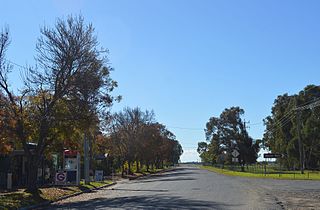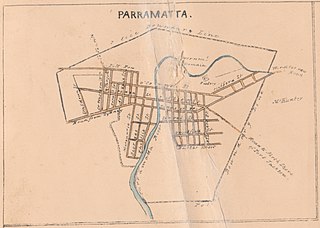Related Research Articles
Daniel Egan was an Australian politician who served as Mayor of Sydney in 1853. He was also a member of the New South Wales Parliament.

Maude is a village on the north bank of the Murrumbidgee River in New South Wales, Australia. It is in between Hay and Balranald in Hay Shire. It is 55 kilometres downstream from Hay and 25 kilometres upstream from the junction of the Lachlan River with the Murrumbidgee. At the 2006 census, it had a population of 161. It consists of a general store, hotel, post office and caravan park. It is surrounded by market gardens supplied with water from Maude Weir, a popular spot for anglers looking for yellow belly, redfin and Murray cod.

Arthur Frederick Jeffreys was an English first-class cricketer and Conservative politician. He served as the Member of Parliament for Basingstoke from 1887 until his death in 1906. As a cricketer, he made 26 appearances in first-class cricket, mostly for the Marylebone Cricket Club, though he also played for Hampshire and in Australia for New South Wales.

Sir William Montagu Manning was an English-born Australian politician, judge and University of Sydney chancellor.

Charles Hotson Ebden was an Australian pastoralist and politician, a member of the New South Wales Legislative Council, the Victorian Legislative Council and the Victorian Legislative Assembly.
Henry Dangar (1796–1861) was a surveyor and explorer of Australia in the early period of British colonisation. Despite an upheld challenge to some of his early land claims, he received huge land grants.
Charles James Fox Campbell was a grazier and early settler of Adelaide, South Australia, whose name is commemorated in the Adelaide suburb of Campbelltown, South Australia and the municipality, the City of Campbelltown, South Australia.

Jeffrey Street or Jeffreys Street is a street located in Kirribilli, famous for being one of the most popular vantage points for views of the city skyline of Sydney, the Sydney Harbour Bridge and the Sydney Opera House. The street is located on the Lower North Shore of Sydney Harbour, directly across the harbour from Circular Quay and is a popular destination for tourists, particularly on Australia Day and New Year's Eve. The street leads uphill from the harbour in a northerly direction to the small shopping village of Kirribilli. For many years the area was called the North Shore and the original land grant changed hands a number of times. Over the past 200 years the area has also been called Huntershill, St Leonards, North Sydney, "Kiarabilli", Milsons Point and "Kirribilli Point". The modern spelling Kirribilli was first used in 1853 and the use of Kirribilli as a locality is more recent.

Samuel Deane Gordon was an Australian merchant, pastoralist and politician. He was a member of the New South Wales Legislative Council between 1861 and 1882. He was also a member of the New South Wales Legislative Assembly for three terms from 1856 until 1860.

Thomas Holt was an English-born Australian pastoralist, company director and politician. He was a member of the New South Wales Legislative Council between 1868 and 1883. He was also a member of the New South Wales Legislative Assembly for two periods between 1856 and 1857 and again between 1861 and 1864. Holt was the first Colonial Treasurer in New South Wales.
George Oakes was an Australian pastoralist and politician. He was a member of the New South Wales Legislative Council for two periods between 1848 and 1856 and again between 1879 and 1881. He was also a member of the New South Wales Legislative Assembly for two periods between 1856 and 1860 and again between 1872 and 1874.

Charles Cowper was an Australian politician, pastoralist and senior public servant, the son of Sir Charles Cowper who served as Premier of New South Wales on five separate occasions between 1856 and 1870. During the period 1860 to 1865 Cowper was the elected member of various electorates in support of his father's political faction. In the late 1860s he invested in pastoral runs in south-west Queensland, which ultimately led to financial losses due to prolonged drought conditions. After a short stint as Police Magistrate at Bourke, Cowper was appointed as the Water Police Magistrate in Sydney. In 1874 he was appointed Sheriff of New South Wales, a position he held until his retirement in 1896.
The Electoral district of City of Sydney was an electorate of the New South Wales Legislative Council.
This is a list of members of the New South Wales Legislative Council from 1851 to 1856. The 1851 Electoral Act increased the number of members in the Council to 54, 18 to be appointed and 36 elected. The initial appointments were made in October 1851. The Speaker was Charles Nicholson.
The 1856 New South Wales colonial election was to return 54 members of Legislative Assembly composed of 34 electoral districts with 18 returning 1 member, 13 returning 2 members, two returning 3 members and one returning 4 members, all with a first past the post system. In multi-member districts, because each voter could cast more than one vote, it is not possible to total the votes to show the number of voters and voter turnout in these districts is estimated. 8 members from 6 districts were returned unopposed.
Charles Kemp was an English-born Australian politician.
The Electoral district of Counties of St Vincent and Auckland was an electorate of the partially elected New South Wales Legislative Council, created for the first elections for the Council in 1843. The electoral district consisted of the two south coast counties of St Vincent and Auckland, extending from Jervis Bay south to Eden and west to Braidwood. Polling took place at Jervis Bay, Ulladulla, Braidwood, Broulee and Eden. The district was abolished with the expansion of the Council in 1851. St Vincent was combined with Murray to the west as the Counties of Murray and St Vincent while Auckland became part of the Pastoral District of Maneroo.

The Electoral district of Town of Parramatta was an electorate of the partially elected New South Wales Legislative Council, created for the first elections for the Council in 1843, at the time the principal residence of the Governor Sir Charles FitzRoy. Polling took place at Parramatta. In 1856, the unicameral Legislative Council was abolished and replaced with an elected Legislative Assembly and an appointed Legislative Council. The district was represented by the Legislative Assembly Parramatta, the only electorate to have existed continuously since the first Legislative Assembly election in 1856.
The 1851 New South Wales colonial election, was held between 12 and 25 September. It involved a re-distribution of electorates as a result of the separation of Victoria, which had 6 seats in the previous council, and the expansion of the council from 24 elected members to 36 elected members representing 31 electorates. The major changes were the addition of 8 pastoral districts and the separate representation for the northern regions of what would later become Queensland. These had previously been a part of the single district of Gloucester, Macquarie, and Stanley and from 1851 were covered by the separate districts of Stanley, Stanley Boroughs and the pastoral districts of Moreton, Wide Bay, Burnett, and Maranoa. The other 8 additional seats were distributed among the nineteen counties of New South Wales.
The Electoral district of Pastoral District of Maneroo was an electorate of the New South Wales Legislative Council at a time when some of its members were elected and the balance were appointed by the Governor. It was a new electorate created in 1851 by the expansion of the Legislative Council to 54, 18 to be appointed and 36 elected. The district covered the Maneroo region now known as Monaro in the south east of New South Wales. To its north was the Electoral district of Counties of Murray and St Vincent. Polling was to occur in the towns of Goulburn, Eden, Cooma and Bombala.
References
- ↑ "Electoral district of Pastoral District of Maneroo". The Sydney Morning Herald . 19 September 1851. p. 3. Retrieved 30 May 2019– via Trove.
- 1 2 3 "Mr Arthur Jeffreys (1811-1861)". Former members of the Parliament of New South Wales . Retrieved 21 May 2019.